Want to know the real deal between reroofing and full roof replacement costs? Let's break it down!
Think of reroofing as putting a sweater over another sweater – you're adding a new layer of shingles on top of what's already there. This smart solution typically saves you 30-50% compared to a complete overhaul, making it easier on your wallet.
A full roof replacement, on the other hand, is like getting a whole new wardrobe. We're talking about stripping everything down to the bare bones, fixing any hidden issues, and starting fresh. While it's more intensive, sometimes it's exactly what your home needs.
When it comes to materials, you've got options that fit every budget. Basic asphalt shingles might set you back $80-130 per square (that's 100 square feet), while premium materials like slate can range from $600-1,600 per square. Labor costs? They're as varied as coffee prices across the country, running anywhere from $30-100 per hour depending on where you live.
Before you jump in, you'll want to check your local building codes and grab those necessary permits. It's like getting a permission slip for a major home makeover! Consider long-term value too – sometimes spending a bit more upfront can save you big bucks down the road.
Key Takeaways
Wondering about the cost difference between reroofing and a complete roof replacement? Let's break it down in a way that won't make your head spin!
Think of reroofing as giving your house a fresh coat – it's like layering a new sweater over an old one. You'll typically save 20-30% compared to a full replacement, making it easier on your wallet right now. We're talking about $5,000-$10,000 for reroofing versus $8,000-$15,000 for a complete overhaul.
But here's the catch – just like that quick fix on your car, reroofing might save you money today but could cost you more down the road. Why? Because those sneaky underlying issues stay hidden, potentially shortening your roof's lifespan.
Your material choices can make your wallet either smile or cry. Asphalt shingles are your budget-friendly buddy at $80-$130 per square, while premium slate is the luxury sports car of roofing at $600-$1,600 per square.
And don't forget about the folks doing the heavy lifting! Labor costs swing like a pendulum depending on where you live. City slickers might pay up to $100 per hour, while rural areas could see rates starting at $30. Location, location, location – it matters just as much in roofing as it does in real estate!
Remember, investing in your roof is like choosing between a quick patch job or a complete engine rebuild – both have their time and place, but knowing which one fits your situation is key to making the smart choice.
Understanding the Key Differences Between Reroofing and Replacement
When homeowners face roofing issues, understanding the fundamental differences between reroofing and roof replacement becomes essential for making informed decisions about their property.
Reroofing benefits include a more cost-effective approach that involves installing new shingles over existing materials, making it ideal for roofs with minor issues and good structural integrity. This method requires less labor and time while effectively extending the roof's lifespan.
In contrast, roof replacement involves complete removal of existing materials, addressing potential replacement drawbacks such as higher costs and longer installation times. While roof replacement can be more expensive and time-consuming initially, it offers the advantage of providing a long-lasting and reliable solution to roofing issues. Additionally, it allows homeowners to upgrade to more modern materials that enhance energy efficiency and boost curb appeal. Therefore, it’s essential to weigh roof replacement benefits and drawbacks carefully to determine the best option for your specific needs. Moreover, homeowners should consider the long-term savings that a roof replacement may provide through improved energy efficiency and reduced maintenance costs. Conducting a thorough roof replacement vs. repair analysis can help identify the best approach based on the condition of the current roof, local climate, and individual budget. Ultimately, making an informed decision will not only protect your investment but also ensure the safety and comfort of your home for years to come.
However, this thorough approach allows for extensive inspection and repair of underlying structural issues, providing a more durable, long-term solution. Local building codes often influence the choice between these options, particularly in areas with specific regulations regarding multiple shingle layers.
The complexity of your roof's design can significantly impact costs, as architectural complexity can increase replacement expenses by 25-50% compared to standard roofing projects.
Cost Breakdown: Materials and Labor
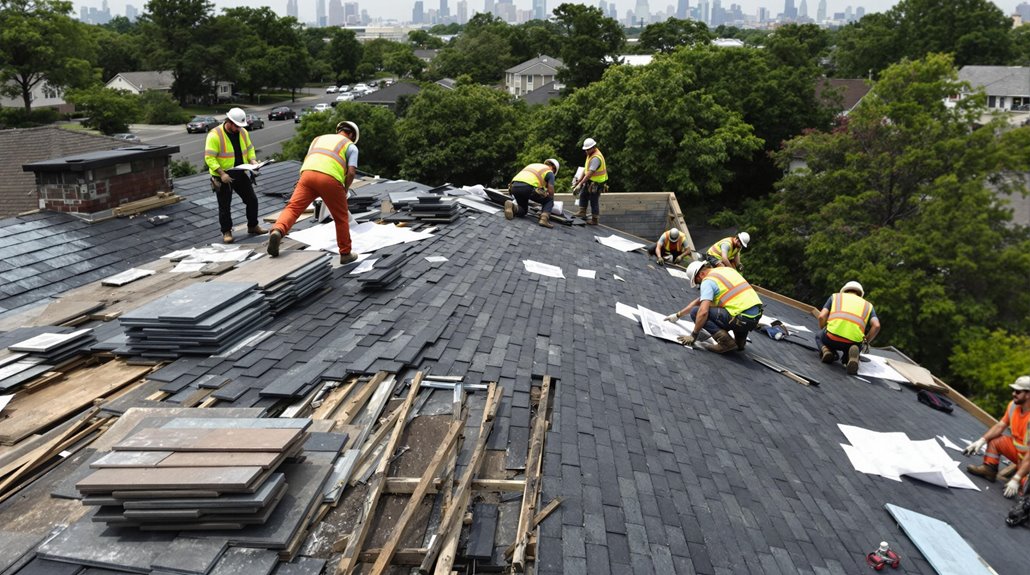
The cost differential between reroofing and roof replacement is greatly influenced by material selection, with prices ranging from economical asphalt shingles to premium metal or slate options.
Labor expenses vary by geographic region, with metropolitan areas typically commanding higher rates than rural locations, while contractor expertise and project complexity further impact overall costs.
Permit fees contribute an additional variable to the total expenditure, as requirements and associated costs differ across municipalities and may depend on the scope of work being performed.
Professional roofers incorporate safety equipment costs ranging from $1,700-4,400 per worker including fall protection systems, personal gear, and specialized footwear.
Material Price Comparisons
Understanding material and labor costs represents an essential first step in any roofing project, with prices varying greatly across different roofing materials.
Asphalt advantages include lower initial costs, ranging from $80-$130 per square, while metal durability justifies its higher price range of $100-$800 per square. Premium materials like tile ($300-$2,500) and slate ($600-$1,600) command higher prices due to their longevity and aesthetic appeal.
Installation costs further differentiate these options, with asphalt requiring minimal specialized labor compared to slate or tile installations.
Material quality, regional availability, and geographical location greatly influence final pricing. The correlation between cost and lifespan becomes evident when comparing asphalt's 15-20 year durability to metal's 30-80 years, or tile's potential 200-year lifespan, making long-term value assessment essential for informed decision-making.
Homeowners should consider that standard insurance policies typically switch from RCV to ACV coverage once a roof reaches 10-15 years of age, affecting potential replacement reimbursements.
Labor Costs By Region
Labor costs for roofing projects exhibit substantial regional variations across the United States, with metropolitan areas commanding premium rates due to higher living expenses and increased demand for skilled workers.
States like Massachusetts, Illinois, and California consistently rank among the highest-paying regions for roofing labor, while states with high concentrations of roofers, such as Florida and Oregon, demonstrate unique regional pricing patterns based on labor availability.
The impact of location on labor expenses is particularly evident in urban centers, where contractors typically charge between $30 to $100 per hour.
Metropolitan areas like Port St. Lucie, FL, and Vallejo-Fairfield, CA, experience elevated labor costs due to their high employment levels of roofing professionals.
Rural areas generally maintain lower labor rates, reflecting differences in local economic conditions and market demand.
Homes with hip roof designs typically incur higher installation costs but provide superior wind resistance compared to traditional gable roofs.
Permit Fee Variables
Building permits for roofing projects encompass a complex fee structure that varies greatly based on location, project scope, and building type. The permit application process includes multiple cost factors that can markedly impact total project expenses.
- Flat rate fees range from $256.62 for single-family homes to $386.22 for other structures in San Francisco, while national averages span $400-$1500.
- Additional costs may include plan reviews ($90-$1000), express examinations ($600-$1000), and technology fees.
- Historical buildings often require special permits with supplementary surcharges.
- Permit fees typically calculate as 0.50% to 2.00% of total construction costs.
- Retroactive permits for unpermitted work can escalate costs to $2,000-$8,000.
These permit fee variations guarantee compliance with local building codes while protecting property owners through proper inspections and quality assurance measures.
Factors That Impact Your Roofing Decision
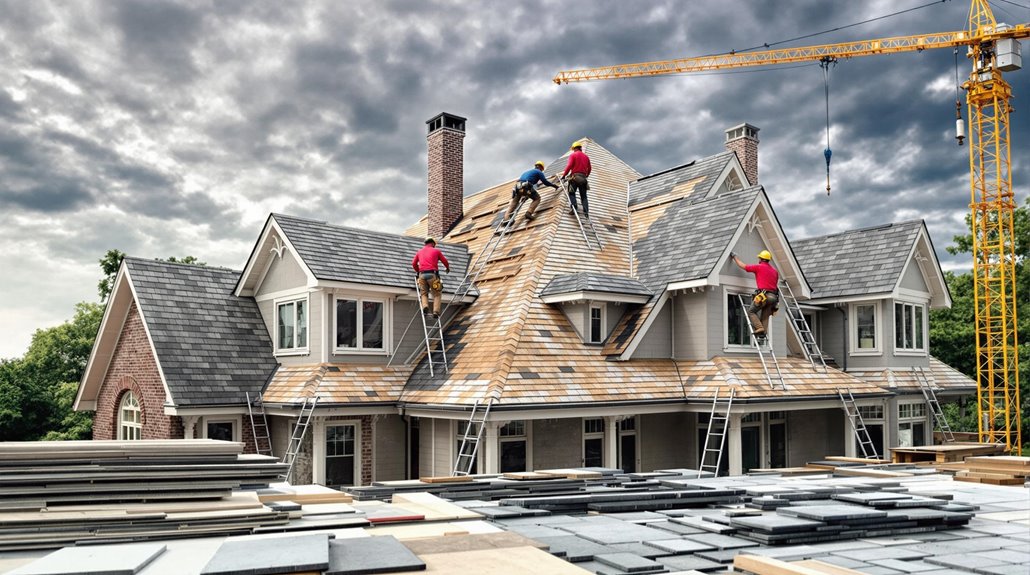
The cost of roofing projects is markedly influenced by material selection, with options ranging from economical asphalt shingles to premium slate or metal systems, each carrying distinct labor requirements and installation complexities.
Local building codes and weather patterns play vital roles in material selection, as regions with heavy snow loads or high winds may require specific roofing systems that meet stringent performance standards.
Labor costs vary based on roof complexity, accessibility, and the contractor's overhead expenses, which typically account for 40-50% of the total project cost.
Keeping existing gutters during roof replacement can increase labor costs 15-25% while extending the project timeline by 1-2 days.
Material and Labor Costs
When evaluating roofing projects, material and labor costs serve as primary factors that influence the final decision between re-roofing and complete replacement.
Material durability and aesthetic appeal greatly impact overall expenses, with options ranging from basic shingles to premium tiles. Labor costs vary based on project complexity, workforce expertise, and regional factors.
Key cost considerations include:
- Material selection and quantity requirements based on roof size
- Removal costs for existing roofing layers
- Complexity of roof design, including angles and features
- Workmanship warranty coverage
- Company overhead and administrative expenses
The combination of these elements determines whether re-roofing or full replacement presents the more cost-effective solution.
While re-roofing typically requires less material and labor, long-term durability and structural considerations may justify the higher investment in complete replacement. Moreover, homeowners should also evaluate roof repair depreciation factors that can significantly impact the overall value of their property. Although a re-roofing project may seem cost-effective initially, hidden issues might arise later, leading to additional expenses. Ultimately, a complete replacement not only enhances the aesthetic appeal but also provides peace of mind regarding the roof’s performance and longevity.
Professional restoration can deliver 50-70% cost savings compared to a complete roof replacement while extending the life of existing materials. In addition to significant cost savings, professional restoration can enhance the structural integrity of your roof, ensuring it remains resilient against the elements. This is particularly important given that typical roof replacement costs 2025 are projected to rise, making restoration an even more appealing option for homeowners. By opting for restoration, you not only save money but also contribute to sustainable practices by minimizing waste and extending the life of your roofing materials.
Weather and Building Codes
Weather patterns and regulatory requirements play essential roles in determining whether homeowners should pursue reroofing or complete replacement. The weather impact on roofing decisions encompasses structural integrity considerations, while code compliance guarantees safety and longevity. Thorough damage documentation requirements must be met before proceeding with either option to ensure proper insurance coverage and compliance.
| Factor | Reroofing | Complete Replacement |
|---|---|---|
| Climate Adaptation | Limited material options for specific weather conditions | Full flexibility to select climate-appropriate materials |
| Building Code Requirements | Must meet existing structure specifications | Allows for extensive code compliance updates |
| Weather Protection | May retain underlying vulnerabilities | Enhanced protection against local weather patterns |
Local building codes often mandate specific requirements for both options, particularly in regions prone to extreme weather events. Factors such as snow loads, wind resistance, and UV exposure greatly influence material selection and installation methods, making weather considerations vital in the decision-making process.
The Long-Term Financial Benefits of Each Option
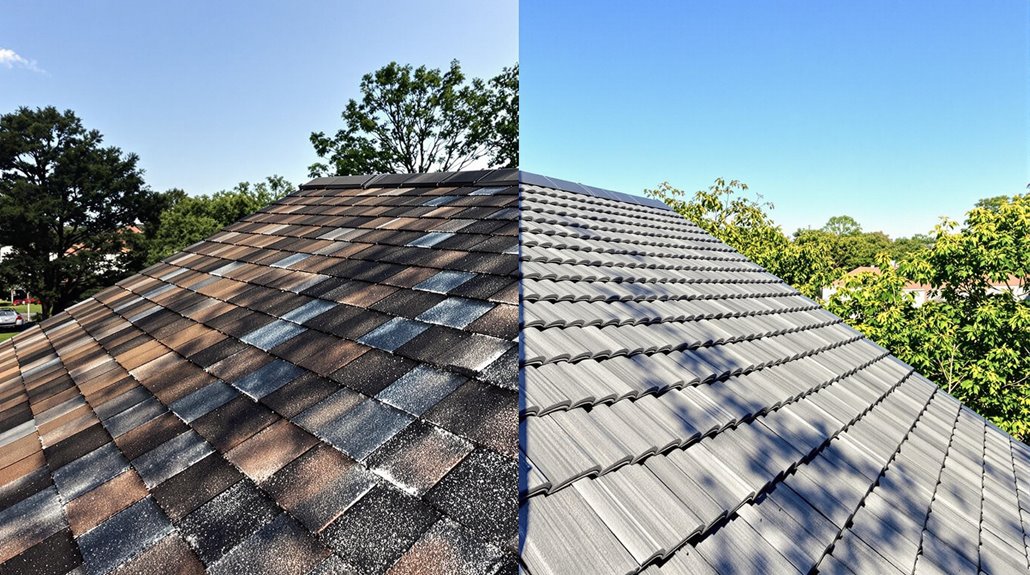
Making an informed decision between reroofing and roof replacement requires careful analysis of their respective long-term financial implications.
While reroofing presents an initially cost-effective solution, an extensive investment analysis reveals that complete replacement often yields superior long-term value. The financial comparison must consider multiple factors that impact overall return on investment.
- Roof replacement offers enhanced durability and extended lifespan, minimizing future maintenance costs.
- Modern materials in new roofs provide improved energy efficiency, reducing utility expenses.
- Complete replacement may qualify homeowners for insurance premium reductions.
- New roofs considerably increase property value and market appeal.
- Full replacement allows for thorough inspection and resolution of underlying structural issues.
Though reroofing requires less upfront investment, its shorter lifespan and potential hidden problems may result in higher cumulative costs over time. Engaging certified roofing contractors for professional assessments can help determine the most cost-effective long-term solution for your specific situation.
Building Codes and Permit Requirements
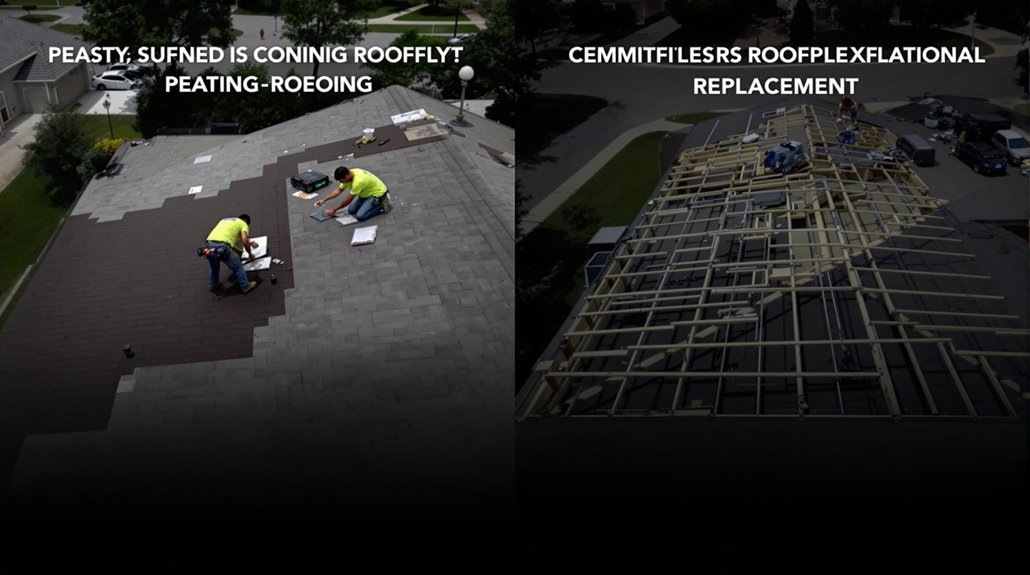
Understanding building codes and permit requirements is critical for any roofing project, particularly in regions governed by strict regulations like the Florida Building Code.
A key regulation is the 25% Reroofing Rule, which mandates complete roof replacement if repairs exceed 25% of the roof area within 12 months.
Building code compliance requires proper permit applications and adherence to specific material and installation standards.
Projects completed after March 1, 2009, with properly closed permits, are exempt from the 25% rule.
The permit application process must follow Sections 1512-1525 of the Florida Building Code, ensuring all repairs use approved components and prevent water ponding.
Properties with roofing systems installed or repaired under the 2007 Florida Building Code or later editions need only update the specific repaired sections to current standards.
Structural Considerations for Your Home

Structural integrity forms the cornerstone of any roofing project, requiring careful evaluation of multiple engineering factors before proceeding with either re-roofing or complete replacement.
A thorough structural assessment must examine load considerations, seismic requirements, and wind uplift potential to guarantee the building can support the intended roofing system.
Key structural factors that require evaluation include:
- Weight capacity of existing structure for additional roofing layers
- Deck condition and ability to support new materials
- Seismic design requirements, especially in categories D, E, or F
- Wind uplift resistance in high-wind regions
- Structural connections and bracing needs
Buildings in seismic zones or high-wind areas require special attention to structural requirements, often necessitating consultation with a structural engineer.
The existing deck condition particularly influences the feasibility of re-roofing versus complete replacement.
Standard plywood decking typically costs $2-$4 per square foot and remains a popular choice for residential structures.
Time and Labor Investment Comparison
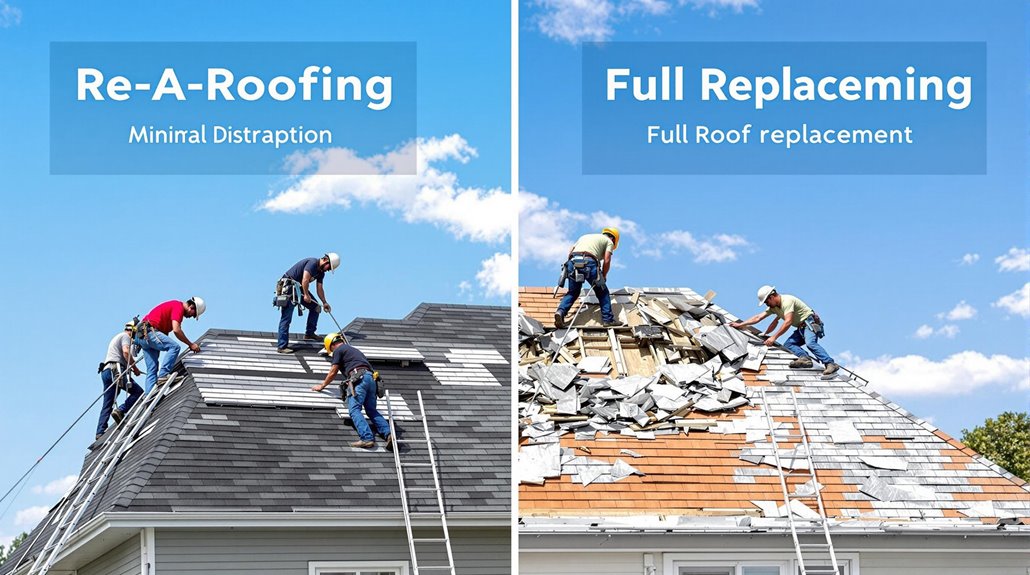
When comparing re-roofing to complete roof replacement, the time and labor investments differ considerably in both scope and complexity.
Re-roofing demonstrates superior time efficiency, often completed within a single day, minimizing disruption to daily household activities. This process requires less labor intensity since it bypasses the extensive removal of existing materials.
In contrast, full roof replacements demand more thorough labor involvement, including tear-off procedures, disposal of old materials, and installation of entirely new components. The increased labor intensity directly affects costs, with replacement projects requiring more worker hours and expertise.
However, the actual time differential between the two options may not be significant for typical residential projects, as factors such as roof size, complexity, and material selection ultimately influence the completion timeline.
Extensive roof deck repairs can add 2-3 business days to the overall project duration.
Environmental Impact and Sustainability
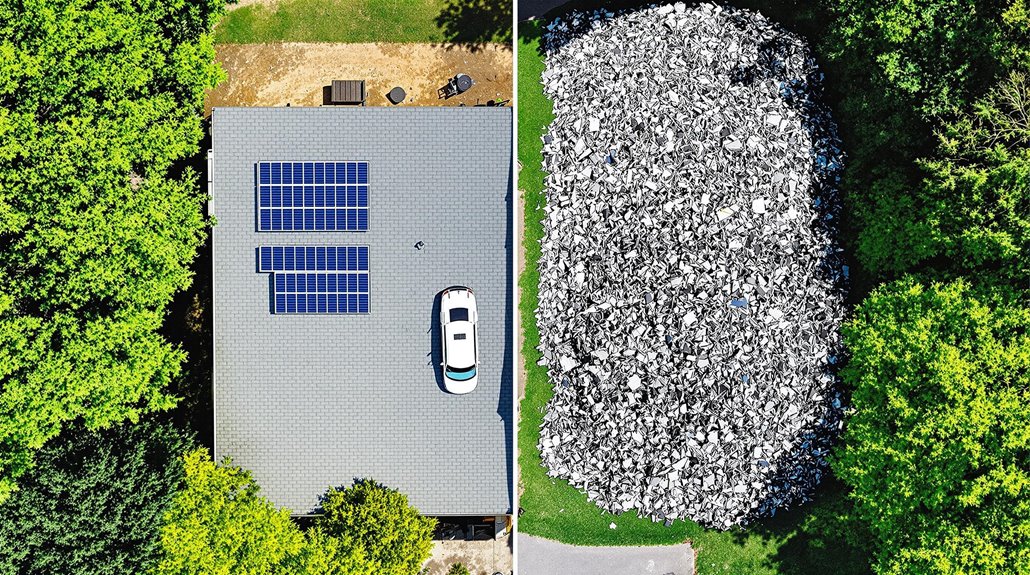
The environmental footprint of roofing decisions carries significant implications for both local ecosystems and global sustainability efforts. When comparing reroofing to complete replacement, the adoption of eco friendly practices and sustainable materials becomes essential.
Full replacements generate substantial waste, with traditional asphalt shingles contributing millions of tons to landfills annually.
Key environmental considerations include:
- Material recyclability and waste reduction potential
- Energy efficiency impact on building performance
- Carbon footprint of manufacturing processes
- Durability and lifecycle sustainability
- Local ecosystem effects and stormwater management
Reroofing typically produces less immediate waste than complete replacement, though long-term sustainability depends on material choices and installation methods.
Modern sustainable materials, including recycled shingles and cool roofing systems, offer environmentally conscious alternatives that reduce both waste generation and energy consumption while promoting building efficiency.
Making the Right Choice for Your Budget and Home
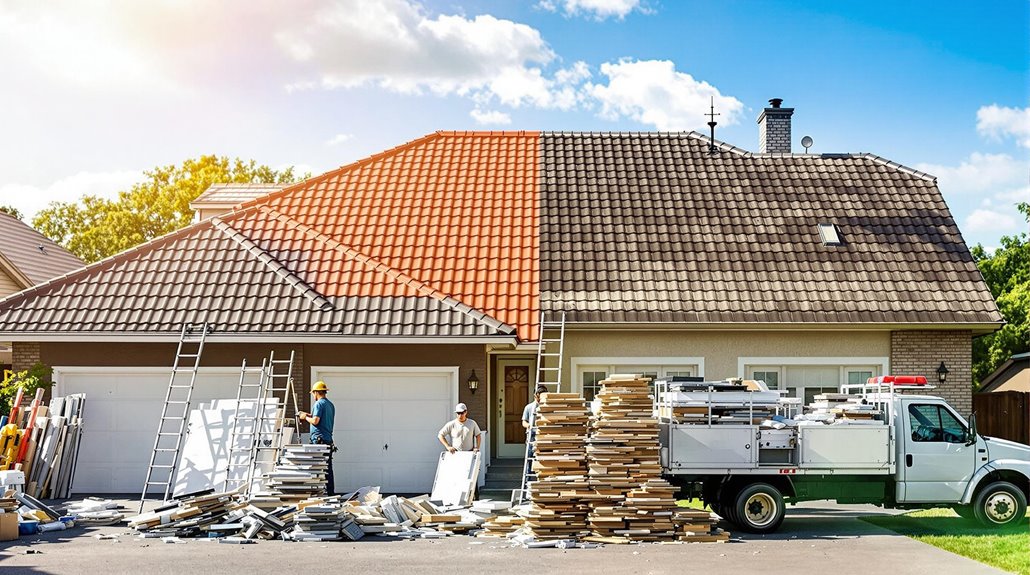
Deciding between reroofing and full replacement requires careful consideration of both immediate budget constraints and long-term financial implications.
A thorough budget analysis should account for material costs, labor expenses, and potential insurance coverage to determine the most cost-effective solution.
While reroofing offers lower upfront costs and faster execution, homeowners must weigh these advantages against roof longevity and future maintenance requirements.
Professional inspections can reveal whether the existing roof structure is suitable for reroofing or if a complete replacement would better serve long-term interests.
Insurance considerations also play a significant role, as many policies favor full replacements, particularly in cases of storm damage.
The decision ultimately depends on balancing current financial resources against the extended benefits and durability that a complete replacement provides.
The Benefits Of Consulting A Public Adjuster

Consulting a public adjuster provides homeowners with professional expertise in maneuvering complex insurance claims during roof repair or replacement decisions.
These licensed professionals conduct thorough, objective assessments of roof damage while managing documentation and negotiations with insurance companies, considerably streamlining the claims process.
Studies indicate that claims handled by public adjusters often result in higher settlements, ensuring homeowners receive adequate compensation for necessary roofing work.
Expertise In Insurance Claims
When facing complex insurance claims for roof damage, professional public adjusters offer invaluable expertise that can greatly impact claim outcomes. Their thorough understanding of insurance policy interpretation and claim negotiation strategies guarantees policyholders receive maximum benefits under their coverage.
Public adjusters navigate intricate policy terms while managing documentation requirements efficiently.
Key aspects of their expertise include:
- Detailed analysis of policy language and coverage limitations
- Strategic preparation of damage assessments and repair estimates
- Professional negotiation with insurance carriers to maximize settlements
- Thorough documentation of proof of loss claims
- Management of potential disputes through evidence-based presentations
This specialized knowledge enables public adjusters to expedite claims processes while guaranteeing fair compensation for roof-related damages, ultimately saving policyholders time and resources during complex insurance negotiations.
Objective Damage Assessment
A thorough objective damage assessment by a public adjuster provides property owners with extensive insights into the true extent of their roof damage. Through detailed roof inspection protocols, adjusters document visible deterioration with detailed photographs while examining critical areas such as attics and surrounding properties for weather-related impacts.
The damage assessment process involves evaluating specific indicators including shingle conditions, structural integrity, and moisture penetration. Public adjusters analyze factors such as the roof's age, pre-existing conditions, and evidence of severe issues like sagging, persistent leaks, or extensive fungal growth.
This systematic evaluation generates detailed documentation necessary for insurance claims, incorporating professional cost estimates and categorized evidence. Their expertise guarantees accurate distinction between scenarios requiring minor repairs versus complete replacement, supporting property owners in securing appropriate settlements.
Streamlined Claim Process
Public adjusters provide distinct advantages in simplifying the complex insurance claims process for roof damage. Their expertise greatly enhances claim efficiency through meticulous documentation accuracy and streamlined procedures. They coordinate all aspects of the claim, from initial assessment to final settlement, guaranteeing thorough documentation and timely submission.
Key elements of their streamlined process include:
- Extensive damage documentation and detailed reporting
- Efficient coordination of inspections and evaluations
- Strategic claim filing that meets all policy requirements
- Professional negotiation with insurance providers
- Continuous claim monitoring and status updates
This systematic approach expedites the claims process while maximizing settlement outcomes.
Public adjusters' thorough understanding of policy requirements and documentation standards guarantees that claims are processed efficiently, reducing delays and complications throughout the settlement process.
Higher Claim Payouts & Settlements
Because insurance claims often involve complex negotiations and detailed assessments, consulting a public adjuster greatly increases the likelihood of securing higher settlements for roof damage claims.
These licensed professionals employ proven settlement strategies, leveraging their expertise in policy interpretation and damage evaluation to maximize compensation.
Public adjusters systematically document all damage using advanced technology, identifying often-overlooked issues that could affect the higher claim value.
Their extensive understanding of insurance company tactics enables them to effectively counter lowball offers and guarantee fair valuations.
The fees charged by public adjusters are typically offset by the increased settlement amounts they secure through their thorough documentation and skilled negotiation.
Their advocacy helps balance the claims process, guaranteeing property owners receive full compensation under their policy terms.
About The Public Claims Adjusters Network (PCAN)
Professional claims advocacy takes shape through the Public Claims Adjusters Network (PCAN), an organization of licensed independent adjusters who represent policyholders during insurance claims.
PCAN members fulfill essential Public Adjuster Roles throughout the Claim Process, operating across all 50 states and internationally to maximize settlement outcomes.
Key aspects of PCAN's professional services include:
- Thorough policy review and damage assessment
- Documentation and validation of claims using industry-leading software
- Direct negotiation with insurance companies
- Emergency response and mitigation services
- Processing of both residential and commercial claims
PCAN adheres to strict regulatory requirements, including mandatory contract documentation, precise communication timelines, and transparent fee structures.
Their expertise often results in claim settlements 300-400% higher than initial insurance offers, while requiring no upfront fees from policyholders.
Frequently Asked Questions
Can I Reroof Over Damaged or Wet Insulation?
Reroofing over damaged or wet insulation compromises insulation integrity and creates severe moisture concerns. Professional removal and replacement of affected materials is necessary to prevent structural damage and mold growth.
How Often Should Roof Inspections Be Performed After Reroofing?
Like watchful sentinels guarding a fortress, post-reroofing maintenance requires annual professional inspections, maintaining the same frequency as standard roofs to guarantee structural integrity and warranty compliance.
What Weather Conditions Are Ideal for Roof Installation?
Ideal weather for roof installation requires temperatures between 50-85°F, low humidity, clear skies, and minimal wind. Installation timing is most favorable during spring and fall when conditions are consistently mild.
Will Reroofing Affect My Home's Resale Value Differently Than Replacement?
Resale impact assessments indicate roof replacement typically increases property value, while reroofing can decrease marketability due to perceived maintenance concerns and reduced structural integrity, affecting overall value assessment outcomes.
Are There Specific Insurance Requirements for Reroofing Versus Full Replacement?
Insurance coverage typically favors full replacements, with stricter policy limitations for reroofing projects. Insurers may require professional inspections and often exclude coverage for reroofing over aged or damaged roofs. Homeowners seeking to navigate these complexities often find themselves negotiating roof replacement with insurance to ensure they receive adequate compensation. It’s crucial to document the condition of the existing roof thoroughly and obtain estimates from licensed contractors to strengthen their case. Additionally, understanding the specific terms of the policy can empower homeowners to leverage their negotiating position effectively. Policyholders should be aware that understanding the specifics of their coverage, including exclusions and limitations, is crucial when planning for roof maintenance or upgrades. It is also important to research the various roof repair types and costs, as these can significantly impact overall insurance claims. Ultimately, being informed about both the insurance guidelines and the financial implications of roof repairs can lead to better decision-making and potentially lower out-of-pocket expenses in the event of damage.
References
- https://roofclaim.com/re-roofing-vs-roof-replacement/
- https://garciadidmyroof.com/blog/roof-replacement-cost-factors-impact/
- https://www.garfield12323.com/roof-repair-vs-replacement/
- https://oldtimeroofing.net/re-roofing-vs-roof-restoration-the-ultimate-comparison/
- https://www.centralroofingllc.net/cost-of-roof-replacement-factors/
- https://www.beaconbasingstokeroofing.co.uk/blog/re-roofing-vs-roof-replacement-what-is-right-for-me-uk/
- https://goldkeyroofing.com/reroofing-versus-roof-replacement-a-comprehensive-examination-of-key-differences/
- https://www.warnerroofinginc.com/blog/re-roofing-vs-roof-replacement-2
- https://www.gen819.com/difference-between-re-roofing-vs-roof-replacement-explained/
- https://staydryroofing.com/top-differences-between-a-reroof-vs-roof-replacement/








